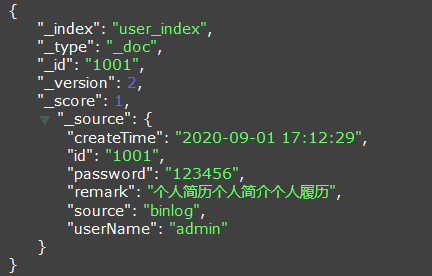使用Lua脚本可以实现更复杂的数据处理逻辑,go-mysql-transfer支持Lua5.1语法
# **示例**
t_user表,数据如下:

## **示例一**
引入Lua脚本:
```
rule:
-
schema: eseap #数据库名称
table: t_user #表名称
order_by_column: id #排序字段,存量数据同步时不能为空
lua_file_path: lua/t_user_es.lua #lua脚本文件
es_index: user_index #Elasticsearch Index名称,可以为空,默认使用表(Table)名称
es_mappings: #索引映射,可以为空,为空时根据数据类型自行推导ES推导
-
field: id #映射后的ES字段名称
type: keyword #ES字段类型
-
field: userName #映射后的ES字段名称
type: keyword #ES字段类型
-
field: password #映射后的ES字段名称
type: keyword #ES字段类型
-
field: createTime #映射后的ES字段名称
type: date #ES字段类型
format: yyyy-MM-dd HH:mm:ss #日期格式,type为date此项有意义
-
field: remark #映射后的ES字段名称
type: text #ES字段类型
analyzer: ik_smart #ES分词器,type为text此项有意义
-
field: source #映射后的ES字段名称
type: keyword #ES字段类型
```
其中,
es_mappings 表示索引的mappings(映射关系),不定义es_mappings则根据字段的值自动创建mappings(映射关系)。根据es_mappings 生成的mappings如下:

Lua脚本:
```
local ops = require("esOps") --加载elasticsearch操作模块
local row = ops.rawRow() --当前数据库的一行数据,table类型,key为列名称
local action = ops.rawAction() --当前数据库事件,包括:insert、update、delete
local id = row["ID"] --获取ID列的值
local userName = row["USER_NAME"] --获取USER_NAME列的值
local password = row["PASSWORD"] --获取USER_NAME列的值
local createTime = row["CREATE_TIME"] --获取CREATE_TIME列的值
local remark = row["REMARK"] --获取REMARK列的值
local result = {} -- 定义一个table,作为结果集
result["id"] = id
result["userName"] = userName
result["password"] = password
result["createTime"] = createTime
result["remark"] = remark
result["source"] = "binlog" -- 数据来源
if action == "insert" then -- 只监听新增事件
ops.INSERT("t_user",id,result) -- 新增,参数1为index名称,string类型;参数2为要插入的数据主键;参数3为要插入的数据,tablele类型或者json字符串
end
```
同步到Elasticsearch的数据如下:

## **示例二**
引入Lua脚本:
```
schema: eseap #数据库名称
table: t_user #表名称
lua_file_path: lua/t_user_es2.lua #lua脚本文件
```
未明确定义index名称、mappings,es会根据值自动创建一个名为t_user的index。
使用如下脚本:
```
local ops = require("esOps") --加载elasticsearch操作模块
local row = ops.rawRow() --当前数据库的一行数据,table类型,key为列名称
local action = ops.rawAction() --当前数据库事件,包括:insert、update、delete
local id = row["ID"] --获取ID列的值
local userName = row["USER_NAME"] --获取USER_NAME列的值
local password = row["PASSWORD"] --获取USER_NAME列的值
local createTime = row["CREATE_TIME"] --获取CREATE_TIME列的值
local result = {} -- 定义一个table,作为结果集
result["id"] = id
result["userName"] = userName
result["password"] = password
result["createTime"] = createTime
result["remark"] = remark
result["source"] = "binlog" -- 数据来源
if action == "insert" then -- 只监听新增事件
ops.INSERT("t_user",id,result) -- 新增,参数1为index名称,string类型;参数2为要插入的数据主键;参数3为要插入的数据,tablele类型或者json字符串
end
```
同步到Elasticsearch的数据如下:

# **esOps模块**
提供的方法如下:
1. INSERT: 插入操作,如:ops.INSERT(index,id,result)。参数index为索引名称,字符串类型;参数index为要插入数据的主键;参数result为要插入的数据,可以为table类型或者json字符串
2. UPDATE: 修改操作,如:ops.UPDATE(index,id,result)。参数index为索引名称,字符串类型;参数index为要修改数据的主键;参数result为要修改的数据,可以为table类型或者json字符串
3. DELETE: 删除操作,如:ops.DELETE(index,id)。参数index为索引名称,字符串类型;参数id为要删除的数据主键,类型不限;
- 简介
- 部署运行
- 高可用集群
- 同步数据到Redis
- Redis配置
- 基于规则同步
- 基于Lua脚本同步
- 同步数据到MongoDB
- MongoDB配置
- 基于规则同步
- 基于Lua脚本同步
- 同步数据到RocketMQ
- RocketMQ配置
- 基于规则同步
- 基于Lua脚本同步
- 同步数据到Kafka
- Kafka配置
- 基于规则同步
- 基于Lua脚本同步
- 同步数据到RabbitMQ
- RabbitMQ配置
- 基于规则同步
- 基于Lua脚本同步
- 同步数据到Elasticsearch
- Elasticsearch配置
- 基于规则同步
- 基于Lua脚本同步
- 全量数据导入
- Lua脚本
- 基础模块
- Json模块
- HttpClient模块
- DBClient模块
- 监控
- 性能测试
- 常见问题
- 更新记录开发计划
